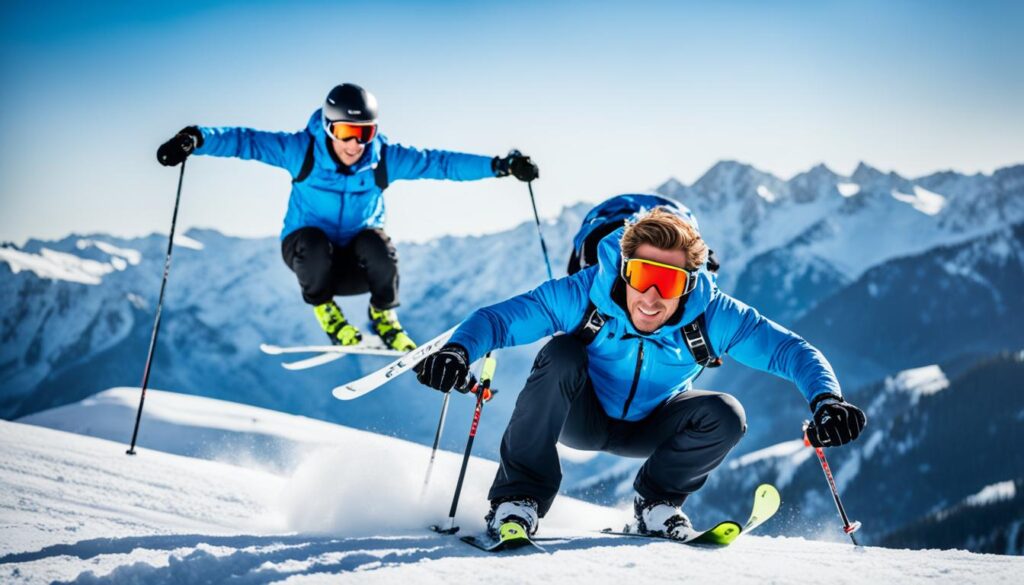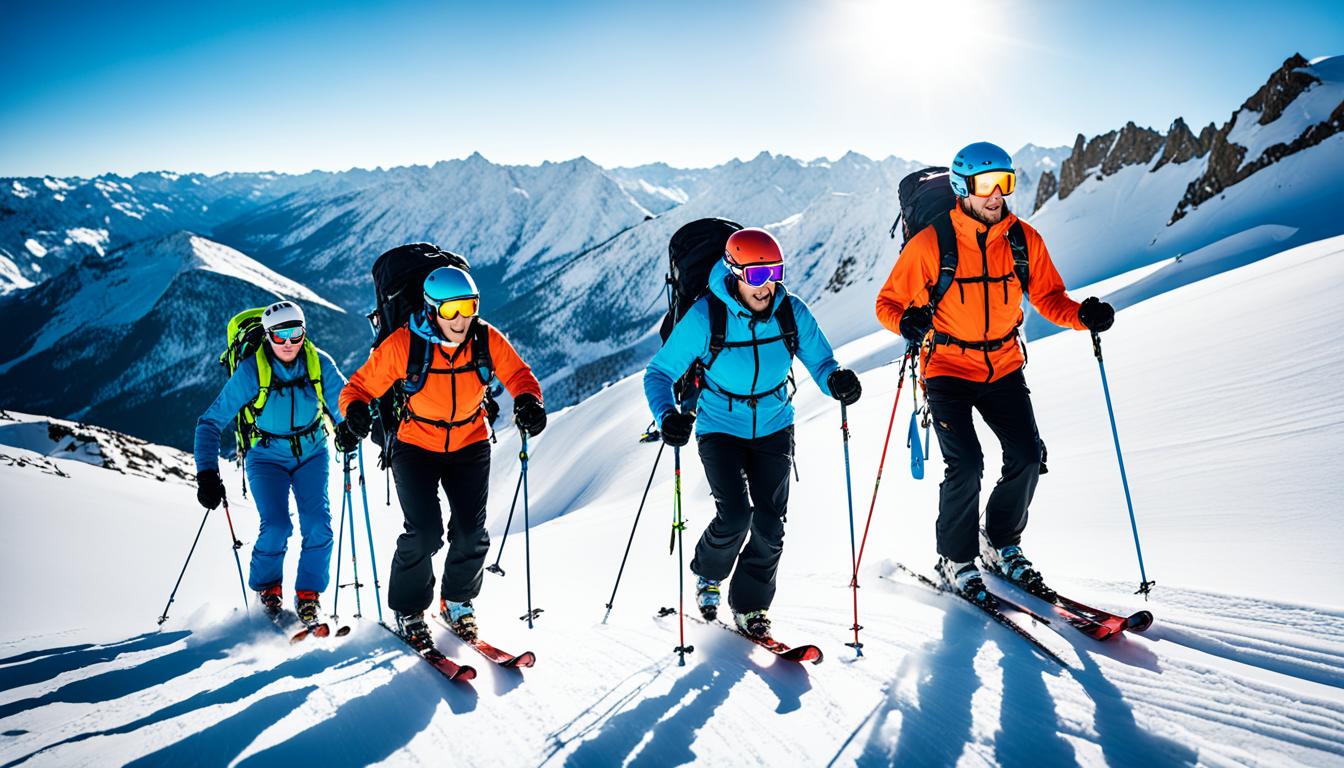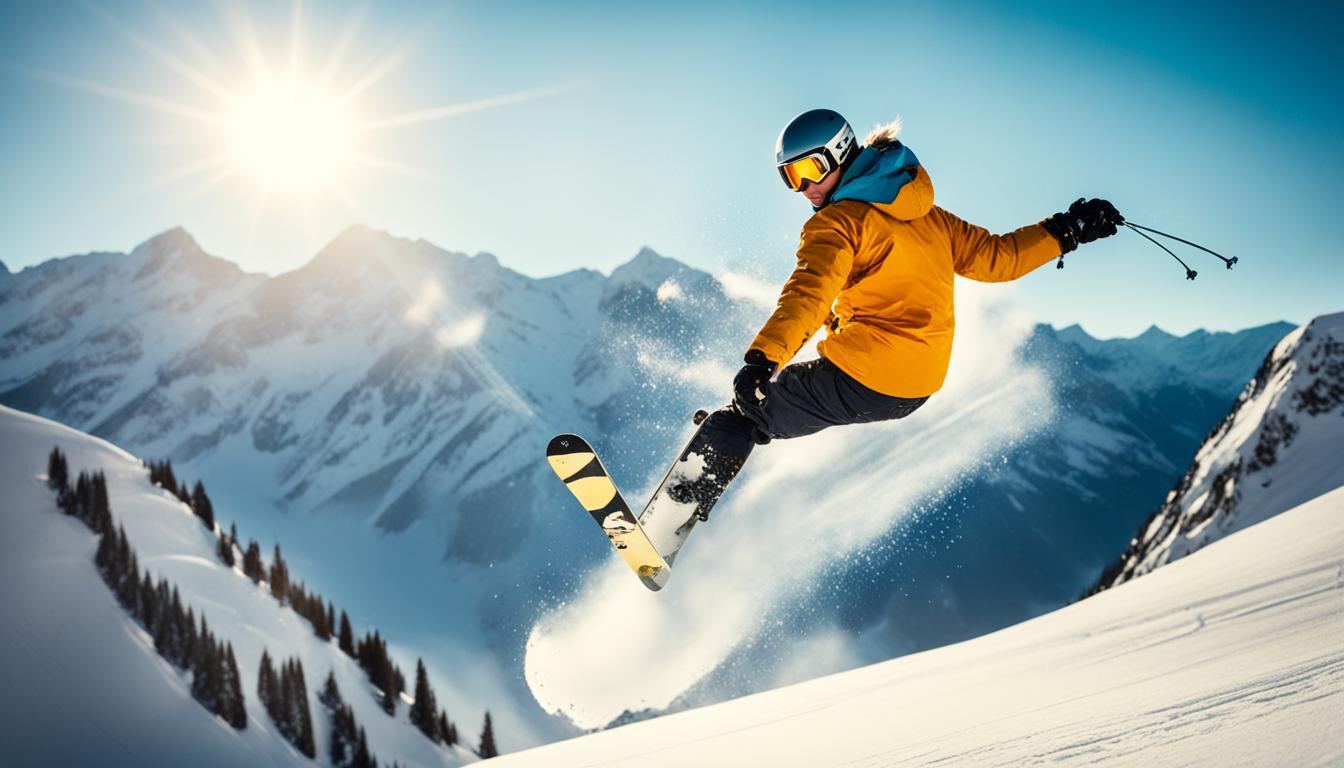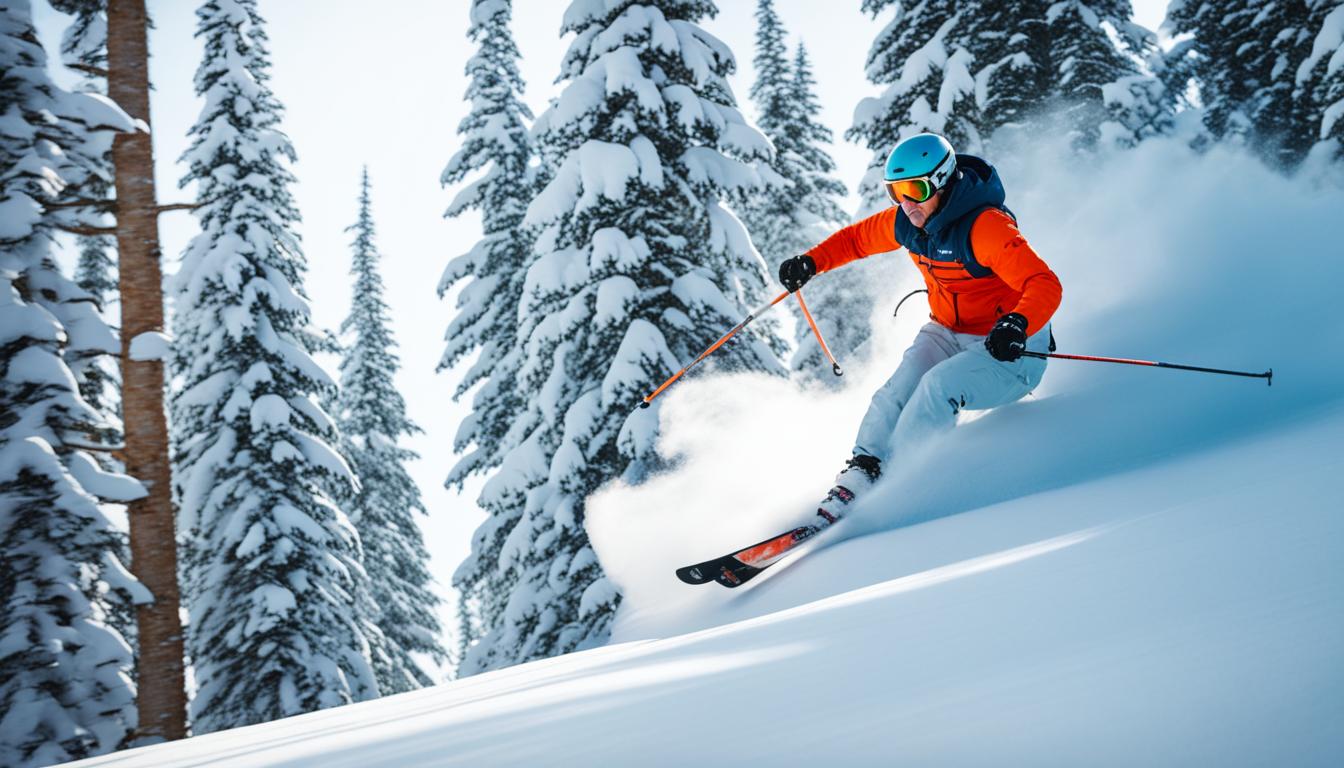Welcome to our comprehensive guide to freestyle skiing and park tricks! Whether you’re a beginner or an advanced skier, we’ve got you covered with expert tips and advice to help you master the thrilling world of freestyle skiing. From essential techniques to safety guidelines, we’ll provide everything you need to know to conquer the terrain park and wow the crowd with your skills and creativity.
Freestyle skiing and park tricks allow you to showcase your style and express yourself on the slopes. It’s an adrenaline-fueled sport that combines athleticism, creativity, and precision. Learning freestyle skiing techniques and tricks will not only elevate your skiing abilities but also enhance your overall enjoyment of the mountain.
In this guide, you’ll learn the basics of freestyle skiing and park etiquette, including safety guidelines and park rules. We’ll also dive into stretching and warm-up exercises that will prepare your body for the physical demands of freestyle skiing. From there, we’ll progress to the fundamentals of popping and basic air maneuvers, introducing you to the exciting world of grabs, switch skiing, spins, and rail sliding.
Key Takeaways:
- Freestyle skiing and park tricks allow skiers to showcase their skills and creativity on the slopes.
- Prioritize safety by familiarizing yourself with park etiquette, signage, and rules.
- Proper stretching and warm-up exercises are crucial for preventing injuries and optimizing performance.
- Mastering popping and basic air maneuvers is essential for generating power and control in tricks.
- Grabs add style and flair to your tricks, and there are various types to learn and incorporate into your skiing repertoire.
So, are you ready to take your skiing to the next level? Let’s dive into the exciting world of freestyle skiing and park tricks!
Basics of Freestyle Skiing and Park Etiquette
Before diving into the world of freestyle skiing and park tricks, it’s crucial to familiarize yourself with the basics and park etiquette. Safety should be our top priority when entering the park, and understanding and following park signage and rules is essential to ensure everyone’s well-being.
When it comes to freestyle skiing, there are some key elements to consider in park etiquette. Knowing how to call your drop, be aware of others on the features, and inspect the conditions before attempting any tricks is crucial. These guidelines not only keep you safe but also contribute to the overall enjoyment of everyone at the park.
Understanding Park Signage and Rules
Freestyle skiing parks have specific signage and rules in place that skiers must adhere to. These signs provide important information about the features, designated areas, and any potential hazards. It’s essential to familiarize yourself with park signage to ensure a safe experience. Pay attention to the following common signage:
- Warning signs: Indicate potential risks or dangers on specific features or sections of the park.
- Feature classifications: Differentiate between beginner, intermediate, and advanced features, helping you choose the appropriate terrain for your skill level.
- Flow and direction signs: Guide the flow of traffic within the park, ensuring skiers maintain a consistent direction on specific features.
- Closed signs: Indicate areas or features that are temporarily closed for maintenance or other reasons. Always respect these closures for your safety.
Calling Your Drop
“Calling your drop” is a common practice in freestyle skiing parks that helps maintain order and prevent collisions on features. When it’s your turn to ride a feature, verbally announce your intention by saying something like, “Dropping in!” or “My turn!” This alerts other skiers to wait their turn and gives you the right of way to perform your trick or line on the feature. Once you’ve completed your run, make sure to clear the landing area promptly to allow others to proceed.”
Being Aware of Others on the Features
Freestyle skiing parks can get crowded, especially during peak times. Being aware of other skiers on the features is crucial for everyone’s safety. Always make a quick scan of the landing area before starting your run, ensuring that no one is in your path or approaching the feature. Similarly, when skiing or riding in the park, maintain awareness of your surroundings and yield to skiers who are already on the features or preparing to drop in.
Inspecting Park Conditions
Prior to attempting any tricks or progressing through the park, take some time to inspect the park conditions. Look for any irregularities, such as icy patches, ruts, or debris that may affect your run. This inspection will help you adjust your line and technique accordingly, ensuring a safer and more enjoyable experience.
Following these safety guidelines and practicing park etiquette will create a positive environment for all skiers in the park. Now that we’ve covered the basics, let’s move on to stretching and warm-up exercises to prepare your body for freestyle skiing.
Stretching and Warm-Up Exercises
Proper stretching and warm-up exercises are essential for preparing your body for the physical demands of freestyle skiing and park tricks. They help improve flexibility, prevent injuries, and optimize your performance on the slopes.
Incorporating these exercises into your pre-ski routine will help you perform at your best and reduce the risk of injuries. Let’s dive into a series of stretching exercises targeting the muscles used in freestyle skiing, such as the legs, back, arms, and core.
Leg Stretch
Start by standing upright with your feet hip-width apart. Take a step forward with your right foot, keeping your back heel on the ground. Bend your right knee and lean forward, feeling a stretch in your left calf and Achilles tendon. Hold for 30 seconds and repeat on the other side.
Back Stretch
Begin by sitting on the ground with your legs extended in front of you. Cross your right leg over your left, placing your right foot flat on the ground. Place your left elbow on the outside of your right knee and gently twist your torso to the right, feeling a stretch in your lower back. Hold for 30 seconds and repeat on the other side.
Arm and Shoulder Stretch
Stand with your feet shoulder-width apart and extend your right arm straight in front of you. Keep your elbow straight and use your left hand to pull your right fingers towards your body until you feel a stretch in your right arm and shoulder. Hold for 30 seconds and repeat on the other side.
| Exercise | Description |
|---|---|
| Leg Stretch | Standing calf and Achilles tendon stretch. |
| Back Stretch | Sitting spinal twist for lower back flexibility. |
| Arm and Shoulder Stretch | Standing arm and shoulder stretch for increased range of motion. |
Remember to perform these exercises in a controlled manner and never bounce or force a stretch. It’s important to listen to your body and only stretch to the point of mild discomfort, not pain. Incorporating these stretching and warm-up exercises into your routine will help prepare your body for freestyle skiing and park tricks, allowing you to perform at your best while minimizing the risk of injuries.

Learning the Fundamentals – Pop and Basic Air Manoeuvres
The fundamentals of freestyle skiing and park tricks start with mastering the techniques of popping and basic air manoeuvres. Popping is essential for generating power and control in all tricks, and it involves explosively extending your joints to initiate airtime. Basic air manoeuvres like shifties, spread eagles, and tail taps are great starting points to develop air awareness and body control while in the air.
Proper execution of the pop is crucial for a successful freestyle skiing performance. Here’s a step-by-step guide:
- Approach the feature with moderate speed, maintaining a balanced and centered stance.
- As you reach the lip, compress your body by bending your knees and ankles.
- Explosively extend your lower body, pushing against the snow to generate upward thrust.
- At the peak of your jump, tuck your knees to your chest, pulling your skis up and initiating the desired trick.
- Extend your body, preparing for a smooth landing.
Mastering basic air manoeuvres requires practice and patience. Here are a few tricks you can start with:
- Shifties: While in the air, shift your weight quickly from one side to the other, creating a twisting motion.
- Spread Eagles: Extend your arms and legs outward, imitating an eagle’s wingspan.
- Tail Taps: Tap the tips of your skis on the tail of a feature, creating a brief moment of weightlessness before landing.
Remember, safety is paramount when attempting freestyle ski tricks. Always wear proper protective equipment, choose features that match your skill level, and progress at your own pace. It’s normal to make mistakes, but learning from them will help you improve.
“Popping and basic air manoeuvres are the foundation of freestyle skiing. Mastering these techniques will set you on the path to executing more advanced tricks and developing your personal style on the slopes.”
Next, we’ll explore the art of grabbing and how it adds style and flair to your freestyle skiing repertoire. But before that, let’s take a moment to visualize the pop and basic air manoeuvres:
Visual guide to popping and basic air manoeuvres
| Technique | Description | Common Mistakes |
|---|---|---|
| Pop | Explosively extending your joints to generate airtime and initiate tricks. |
|
| Shifties | Quickly shifting your weight from one side to the other in mid-air, creating a twisting motion. |
|
| Spread Eagles | Extending your arms and legs outward, mimicking an eagle’s wingspan. |
|
| Tail Taps | Tapping the tips of your skis on the tail of a feature, creating a brief moment of weightlessness. |
|
Introduction to Grabs
Grabs are an integral part of freestyle skiing, bringing style and flair to your tricks. Mastering grabs is crucial for advancing your skills and adding variety to your runs. In this section, we will explore different types of grabs and provide you with techniques and tips to execute them with finesse.
| Grab | Description |
|---|---|
| Safety | Grabbing the skis with one hand in a symmetrical position. |
| Mute | Grabbing the skis with one hand on the inside of the ski. |
| Tail | Grabbing the tail of the ski with one hand. |
| Japan | Grabbing the ski in front of the binding with one hand. |
| Critical | Grabbing the ski in front of the binding with both hands crossed over. |
Each grab requires specific hand and body positioning to execute correctly. Practice these grabs on flat snow to build confidence and control before attempting them on jumps. Incorporating grabs into your freestyle skiing repertoire will not only elevate your style but also impress onlookers with your creativity.
Remember, grabs should be executed in a smooth and controlled manner, ensuring that you maintain balance and stability throughout your trick. Now, let’s dive into the techniques of performing grabs and add another exciting dimension to your freestyle skiing adventure.
Switch Skiing and 180s
Switch skiing, also known as skiing backwards, is a crucial skill for freestyle skiing and performing tricks in the park. It allows you to seamlessly transition between features and adds a unique flair to your skiing repertoire. Mastering switch skiing requires proper body positioning, balance, and turning techniques. Here, we’ll guide you through the steps of skiing switch and provide helpful tips on maintaining balance and control.
When skiing switch, it’s important to remember that your body should be facing uphill while your skis are pointed downhill. This opposite alignment may feel strange at first, but with practice, it will become more natural. To initiate turns, shift your weight and pressure to the respective edges of your skis, just like in regular skiing. Maintaining a centered and balanced stance is crucial to skiing switch effectively.
Tip: Start by practicing switch skiing on groomed runs or easy terrain before progressing to more challenging features in the park. Focus on maintaining control and gradually increase your comfort level!
In addition to switch skiing, learning 180-degree spins is essential for expanding your repertoire of freestyle ski tricks. A 180 involves rotating your body and skis 180 degrees while in the air or on the ground. It serves as the foundation for more advanced tricks like 360s and beyond. To execute a 180, generate momentum and pop off the lip or jump. As you leave the ground, twist your body and skis in the desired direction, aiming for a smooth and controlled landing.
Remember to always spot your landing and maintain proper body positioning throughout the rotation. With practice and determination, you can master the 180 and conquer new challenges in freestyle skiing.

The Benefits of Switch Skiing and 180s
Switch skiing and 180s offer several benefits for freestyle skiers:
- Enhanced versatility: Switch skiing allows you to navigate obstacles and features from different angles, providing greater versatility in your lines and creativity in your tricks.
- Improved coordination: The technical demands of switch skiing and executing 180s require improved coordination between your upper and lower body, leading to enhanced overall skiing skills.
- Progression opportunities: Mastering switch skiing and 180s serves as a stepping stone to more advanced tricks, such as 360s, 540s, and spins off larger jumps.
- Style and creativity: Incorporating switch skiing and 180s into your freestyle runs adds style, variety, and flair, making your skiing more visually appealing and captivating.
Now that you have a solid foundation in switch skiing and 180s, it’s time to progress further and explore more advanced maneuvers. In the next section, we’ll introduce you to 360-degree spins and sliding rails, taking your freestyle skiing skills to new heights!
Progressing to 360s and Rails
Once you’ve mastered the basics of freestyle skiing and park tricks, it’s time to take your skills to the next level by progressing to more advanced maneuvers like 360-degree spins and sliding rails. These tricks require a combination of technique, body control, and confidence, but with practice, you can become a master of freestyle skiing.
The Art of the 360 Spin
To execute a 360 spin, start by approaching a jump with speed and pop into the air. As you leave the lip of the jump, twist your body in the direction you want to spin, using your arms and core to initiate the rotation. Spot your landing during the spin to maintain balance and control.
To increase the height and style of your 360, focus on generating more power with your pop by extending your legs and arms explosively. As you become more comfortable with the trick, experiment with different grab variations to add style and creativity to your spins.
Remember, mastering the 360 takes time and practice, so start with smaller jumps and gradually work your way up to larger features as you build confidence. Always prioritize safety and wear appropriate protective gear when attempting advanced tricks.
Sliding Rails with Style
Sliding rails is another thrilling aspect of freestyle skiing that adds variety and excitement to your runs. It requires balance, edge control, and coordination to navigate the rails with finesse.
Approach the rail with enough speed to maintain momentum and stability. As you reach the rail, bend your knees and center your weight to maintain balance. Use your edges to establish grip on the rail and control your speed. Slide along the rail with confidence, focusing on maintaining a stable body position and fluid movement. Spot your landing as you reach the end of the rail to ensure a smooth transition.
When progressing to more advanced rail tricks, such as spins or presses, it’s important to practice on smaller and less technical rails before attempting more challenging ones. Always assess the rail’s condition and check that it’s securely fastened before sliding.
Summary
As you progress in freestyle skiing, mastering 360s and rails will open up a whole new world of possibilities for tricks and creativity. Remember to start small, practice regularly, and prioritize safety. With time and dedication, you’ll be executing stylish spins and sliding rails with confidence and skill.
Conclusion
Congratulations! You’ve completed our comprehensive guide to freestyle skiing and park tricks. Throughout this guide, we’ve provided you with valuable insights and techniques to enhance your freestyle skiing journey.
We emphasized the importance of safety, starting with the basics, and progressing at your own pace. By prioritizing safety, you can ensure that your freestyle skiing experience is both enjoyable and injury-free.
Remember, practice is key. With dedication and a willingness to push your limits, you’ll be able to showcase your skills and creativity in the terrain park. So grab your skis, head to the slopes, and unleash your potential in the exciting world of freestyle skiing and park tricks!
FAQ
What are freestyle skiing and park tricks?
Freestyle skiing and park tricks are an exhilarating aspect of skiing that allow skiers to showcase their skills and creativity on the slopes. It involves performing various maneuvers, jumps, and tricks in terrain parks, emphasizing style, technical ability, and innovation.
How important is park etiquette in freestyle skiing?
Park etiquette is crucial in freestyle skiing to ensure everyone’s safety and enjoyment. Understanding and following park signage and rules, respecting other skiers’ turns, and being aware of your surroundings are all essential for a positive park experience.
What are some basic warm-up exercises for freestyle skiing?
Proper stretching and warm-up exercises are essential for preparing your body for the physical demands of freestyle skiing. Some recommended exercises include leg swings, arm circles, squats, lunges, and trunk rotations.
How do I perform basic air maneuvers in freestyle skiing?
Basic air maneuvers in freestyle skiing, such as shifties, spread eagles, and tail taps, are great starting points to develop air awareness and body control. These tricks involve using your legs and body movements to manipulate your skis and perform stylish tricks in the air.
What are grabs in freestyle skiing?
Grabs are a signature element of freestyle skiing and add style and flair to your tricks. They involve reaching down and grabbing a specific part of your skis while in the air. There are various types of grabs, such as safety, mute, tail, Japan, and critical, each requiring specific hand and body positioning.
How do I ski switch in freestyle skiing?
Switch skiing, or skiing backward, is a vital skill for performing tricks in the park and transitioning between features. It involves proper body positioning, balance, and turning techniques. Practice skiing switch on flatter terrain until you feel comfortable before attempting it on more challenging features.
How do I progress to more advanced maneuvers in freestyle skiing?
Once you’ve mastered the basics, you can progress to more advanced maneuvers like 360-degree spins and sliding rails. These require a combination of technique, body control, and confidence. Practice on smaller jumps and shorter rails before attempting more challenging features.
Any final tips for freestyle skiing and park tricks?
Congratulations! You’ve completed our comprehensive guide to freestyle skiing and park tricks. Remember to always prioritize safety, start with the basics, and progress at your own pace. With practice, dedication, and a willingness to push your limits, you’ll be able to showcase your skills and creativity in the terrain park. So grab your skis, head to the slopes, and have a blast exploring the world of freestyle skiing and park tricks!




